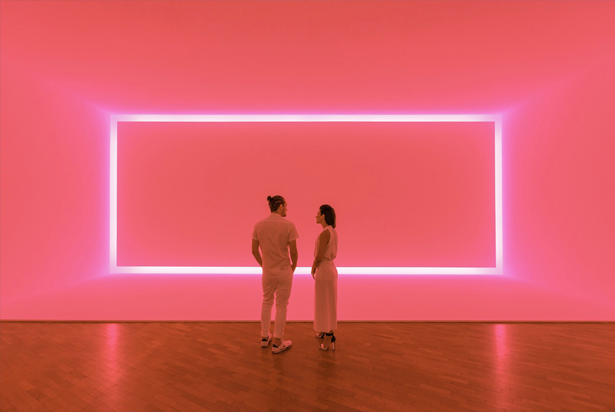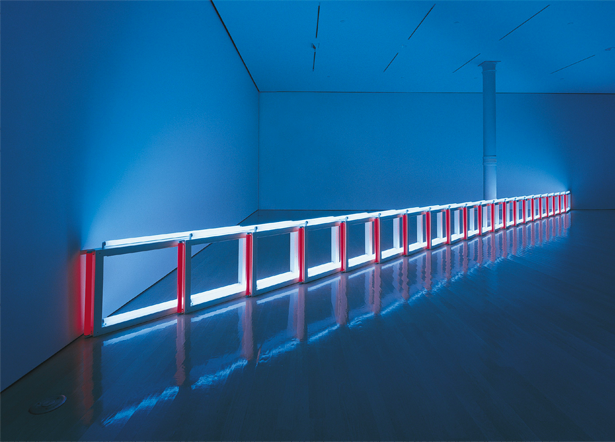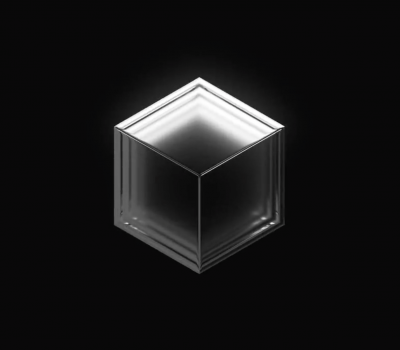
Light has long been chased by visual artists. Seeking to represent its myriad effects on volume, form and space, light is the elusive poem that illuminates the tenderness of an outstretched hand, the warm enveloping glow of atmosphere, the harsh glare of exposure. Light is chased across disciplines, as when a sculptor chisels stone away and light enters, when a painter brushes mists of chiaroscuro to deepen distance, or when splinters of light are carved and chipped from a woodblock bringing shards of light into the darkness of ink. Quite apart from representing light however is light art, in which the element of light is everywhere: light is the medium, sometimes the object, often even the self-reflective subject of the work. The lines are blurred in light art where light is the phenomenon, the medium and the technology, all at once. This blurring was evident in the Vivid festival in Sydney recently, which celebrated the architectural spaces of the city by night through a series of visually stunning and technically proficient light displays by a number of contemporary light artists.
In seeking to nominate the few most influential light artists of today though, the work of James Turrell comes to mind immediately. Turrell’s light art is based in phenomenology and the mystery of perception. His installations offer an intense and often personal encounter with what seems to be a rarefied and purified form of light, enhanced by the viewing (or experiential) space. Every aspect of these spaces, whether an open-sky observatory, like the permanently installed skyspace Within Without at the NGA or the coffin-like chambers of Perceptual Cells are crafted and tuned to heighten the human sensation of receiving light. There is a psycho-physical, even mystical dimension to the experience, as the characteristics of light, colour and space are felt, rather than observed. Viewers are carefully led and subtly guided into states of disorientation and weightlessness, left only to see, and as Turrell has described it,
“There’s a sweet deliciousness to seeing yourself seeing.” James Turrell[i]
As immaterial sensate perception – a behind the eye seeing[ii] is the aim of Turell’s installations, the technology creating these sophisticated and subtle lighting effects are hidden from view, so as not to distract the viewer. At the other end of the light-as-material spectrum then is light artist Dan Flavin, a contemporary of Turrell. Flavin works with the brute visual fact of light as a designed container source of illumination – definitely a front of the eye seeing.
Flavin’s works are instantly recognisable through his signature use of industrially mass-produced fluorescent light tubes to transform architectural space. This is a light that is ready-made, standardised and generic. It brings with it an everyday material facticity, available only in limited sizes and colours. Fluorescent light is harsh and unforgiving, a practical light for working under and yet … when placed in a gallery or museum context, Flavin’s serially modular placement and repetition of fluoro tube lights somehow transform the site, dematerialising the very material elements (nothing is hidden here) and proportions of the space. Never a romantic, Flavin preferred to use the terms light ‘situations’ or ‘propositions’ over ‘sculptures’.

It is an austere light art, resolutely factual and framed in the structural language of in-situ Minimalism. One of Flavin’s oft-quoted aphorisms sums up his approach;
“It is what it is and it ain’t nothing else.” Dan Flavin[iii]
It is interesting to note that these pioneering and lauded light artists both made works that reference the influence of the Russian Constructivists and non-objective movements. Turrell’s Ganzfelds[iv] function as a complete colour-field, enveloping viewers in a gradual loss of depth-perception. Presented as a 3-dimensional space of pure colour contained within a geometric boundary it feels like entering a Josef Albers painting. Dan Flavin acknowledged the historical influence with his long-running series of Monuments to V. Tatlin (1964-1990), a rendition in light of a never-built building, and again in Greens crossing greens (to Piet Mondrian who lacked green) (1966).
Perhaps more interesting than the issue of influence is the question of how earlier light art makes us look at contemporary light art in a new way. Significantly, the rise of early light art coincided with the formulation of non-objective art and the pursuit of abstraction – signalling the break with representation, painting and the past. The abstract geometric language of form, movement and structure in space were intrinsic to early modern light works. Artists associated with Suprematism, Constructivism and the Bauhaus school experimented with the use of light as an active material element in their work. As we know, the history of Modernism and the plurality of manifesto-driven art movement –isms coincided with the increasing ubiquity and integration of developments in light into daily life. Art after each war was characterised by cyclical dystopic – utopic approaches and the latter, brimming with the promise of change made use of the technology of the time, including lighting.
El Lissitszky,[v] a mentee of Kazimir Malevich, may have presented the first abstract geometric installation to use lighting elements in Proun Room (1923, Berlin). In an exhibition space of less than 3m3, light sources and effects were used, together with abstract forms to create an integrated spatial and temporal experience different from the passive experience of observing a painting[vi]. Indeed, the effect seems to be that of entering the pictorial space described by a Constructivist painting as it enables a negotiation between real and illusory space.
Within the same decade, Moholy-Nagy[vii], who was to become influential within the Bauhaus and later, Black Mountain College had developed the fantastically nicknamed kinetic work, the Light-Space Modulator (1930, Paris). The device projected white and coloured light through mechanised, reflective metal and glass components to create moving shadows and reflections in space. Moholy-Nagy used light as a medium but also saw light, shade and texture itself as subject.
‘I became interested in painting with light, not only on the surface of canvas but directly on to space’. László Moholy-Nagy [viii]
Lissitszky’s modest installation and Moholy-Nagy’s machine are the precursors of today’s light art. In the wake of these early models, light works came to increasingly focus on the perceptual processes of a viewer, and the notion that an embodied viewer in space was a necessary element to complete the work. This was a fundamental shift on many levels, from artist to viewer, from passive to active, from seeing to perceiving, from front of the eye to behind the eye.
The power of light as a medium is intrinsically linked to seeing, and from seeing to the phenomena of memory, association and emotion. Poets have long recognised this facility and long before electric light, or James Turrell, William Wordsworth described his memory of a field of yellow daffodils in terms of light, as a “flash upon the inward eye, which is the bliss of solitude”.[ix] The inward eye is often called upon in interpreting contemporary light art.
Lisa Sharp
July 2017
—
[i] James Turrell, American, b.1943
[ii] ‘Behind the eye seeing’ is a term used by James Turrell.
[iii] Dan Flavin, American, 1933-1996
[iv] “Ganzfeld” is a German word meaning “total field” and describing the total loss of depth perception.
[v] Lazar Markovich Lissitszky (known as El Lissitszky), Russian, 1890-1941
[vi] Éva Forgács “Definitive Space: The Many Utopias of El Lissitzky’s Proun Room” in Situating El Lissitzky: Vitebsk, Berlin, Moscow, Eds. Nancy Perloff and Brian Reed, 2003, Getty Research Institute, Los Angeles, 50
[vii] László Moholy-Nagy, Hungarian, 1895-1946
[viii] A Memory of Moholy-Nagy, 1990, video, Dan Spegel prod. Published on Youtube Dec 11, 2011
[ix] William Wordsworth, extract from I wandered, lonely as a cloud, 1802.



